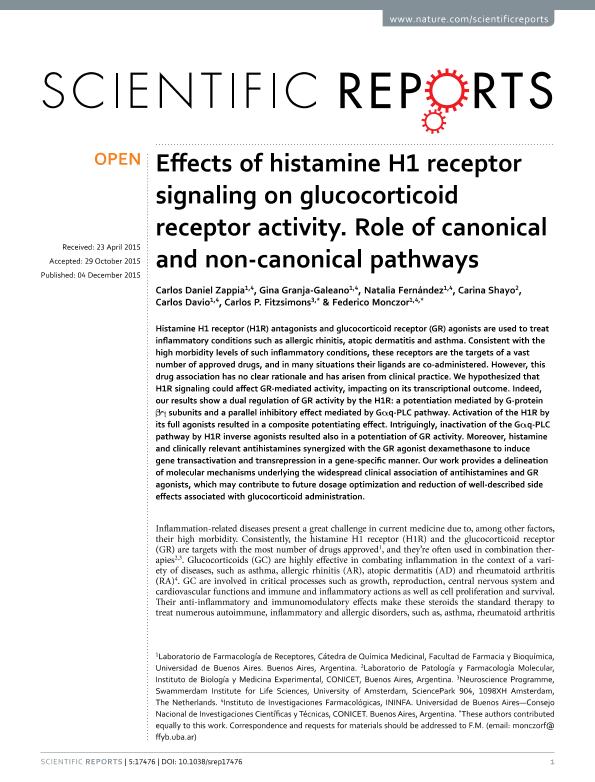Artículo
Effects of histamine H1 receptor signaling on glucocorticoid receptor activity. Role of canonical and non-canonical pathways
Zappia, Carlos Daniel ; Granja Galeano, Gina
; Granja Galeano, Gina ; Fernandez, Natalia Cristina
; Fernandez, Natalia Cristina ; Shayo, Carina Claudia
; Shayo, Carina Claudia ; Davio, Carlos Alberto
; Davio, Carlos Alberto ; Fitzsimons, Carlos P.; Monczor, Federico
; Fitzsimons, Carlos P.; Monczor, Federico
 ; Granja Galeano, Gina
; Granja Galeano, Gina ; Fernandez, Natalia Cristina
; Fernandez, Natalia Cristina ; Shayo, Carina Claudia
; Shayo, Carina Claudia ; Davio, Carlos Alberto
; Davio, Carlos Alberto ; Fitzsimons, Carlos P.; Monczor, Federico
; Fitzsimons, Carlos P.; Monczor, Federico
Fecha de publicación:
12/2015
Editorial:
Nature Publishing Group
Revista:
Scientific Reports
e-ISSN:
2045-2322
Idioma:
Inglés
Tipo de recurso:
Artículo publicado
Clasificación temática:
Resumen
Histamine H1 receptor (H1R) antagonists and glucocorticoid receptor (GR) agonists are used to treat inflammatory conditions such as allergic rhinitis, atopic dermatitis and asthma. Consistent with the high morbidity levels of such inflammatory conditions, these receptors are the targets of a vast number of approved drugs, and in many situations their ligands are co-administered. However, this drug association has no clear rationale and has arisen from clinical practice. We hypothesized that H1R signaling could affect GR-mediated activity, impacting on its transcriptional outcome. Indeed, our results show a dual regulation of GR activity by the H1R: a potentiation mediated by G-protein βγ subunits and a parallel inhibitory effect mediated by Gαq-PLC pathway. Activation of the H1R by its full agonists resulted in a composite potentiating effect. Intriguingly, inactivation of the Gαq-PLC pathway by H1R inverse agonists resulted also in a potentiation of GR activity. Moreover, histamine and clinically relevant antihistamines synergized with the GR agonist dexamethasone to induce gene transactivation and transrepression in a gene-specific manner. Our work provides a delineation of molecular mechanisms underlying the widespread clinical association of antihistamines and GR agonists, which may contribute to future dosage optimization and reduction of well-described side effects associated with glucocorticoid administration.
Archivos asociados
Licencia
Identificadores
Colecciones
Articulos(ININFA)
Articulos de INST.DE INVEST.FARMACOLOGICAS (I)
Articulos de INST.DE INVEST.FARMACOLOGICAS (I)
Citación
Zappia, Carlos Daniel; Granja Galeano, Gina; Fernandez, Natalia Cristina; Shayo, Carina Claudia; Davio, Carlos Alberto; et al.; Effects of histamine H1 receptor signaling on glucocorticoid receptor activity. Role of canonical and non-canonical pathways; Nature Publishing Group; Scientific Reports; 5; 12-2015; 17476
Compartir



